Over 20 years ago, Laurie Kardos ’98 and Jesse Marmon ’97 founded The Artemis Project while they were undergraduates in the computer science department. To this day, the project continues to provide free educational programming in STEM to rising ninth grade students of underrepresented genders.
The Artemis Project was created to maintain interest in math and science among girls entering high school, said Anne Spalter ’87, an Artemis Project collaborator. “It was based on research that showed that a lot of girls were interested in math and science, but something dramatic happened between 8th and 9th grade,” she added.
The goal of the project was orginally to make computer science courses more accessible for this demographic, said Professor of Computer Science Andy van Dam, who serves as a lecturer at The Artemis Project. “We sponsored it through the National Science Foundation grant, and (Spalter) and I did some lectures, and over the years it came to have its current form.”
“(The Artemis Project) has morphed over the years,” and has now become a mix of general science and computer science, van Dam added. “The idea is that it would be project-based, and there would be field trips and bonding exercises of various kinds so that it wasn’t just summer school. It was meant to be kind of a combination of summer school and summer camp,” hesaid.
Exposure to upper-level educational resources largely impacts the future decisions kids can make about college and what interests they pursue, Spalter said. With this in mind, The Artemis Project brings a small group of pre-high school students of underrepresented genders to campus for five weeks. “They (have) literally never walked onto a college campus, so just being there and feeling like they could go to college was a huge thing,” she added.
“I find (the students) incredibly enthusiastic and fearless … they really enjoy being taken seriously,” van Dam said.
Nirva LaFortune, an alumnus of The Artemis Project, is the manager and advisor of the Presidential Scholars Program at Brown and also serves a representative of Ward 3 on Providence City Council. LaFortune noted the importance of students having role models who look like them in college environments. “When you’re in a community where no one in your family has gone to college, you don’t have a model to follow. I didn’t have a model. But having this experience provided me with a network, and so we have to teach our kids how to build their network of resources,” she said.The group LaFortune was a part of was comprised of girls from myriad backgrounds, which improved their experience, she said. “A lot of our activities were focused on team building … but we were also forming a community amongst ourselves. We had space to discuss issues that impacted us,” LaFortune said.
“You never know what’s going to change someone’s future. Sometimes just meeting one person, one experience, can have a huge impact,” Spalter said. The program is successful because of how invested Brown student leaders and teachers are, she added.
“We need to provide kids with more access to life outside of their neighborhoods and outside of their communities,” LaFortune added. Without resources, kids will continue to be disadvantaged as they compete with others who have access to the necessary resources to be successful, she said.
It’s important to invest in our youth regardless of the costs because they will eventually re-invest in their communities, LaFortune said. “Sometimes the only opportunity for kids to be exposed to these additional (resources) is when they have these summer opportunities,” she added.
LaFortune said she wants to advocate for more student resources and partnerships with universities. “These are opportunities to develop leaders. People who are able to cultivate these ideas and bring it back into their communities,” LaFortune said.
“There is still inadequate attention being paid to schools that don’t have as many resources … the more enrichment programs after school and during the summer, the better,” van Dam said.





